Finding the Right Pressure Calibrator for Your Pressure Gauges
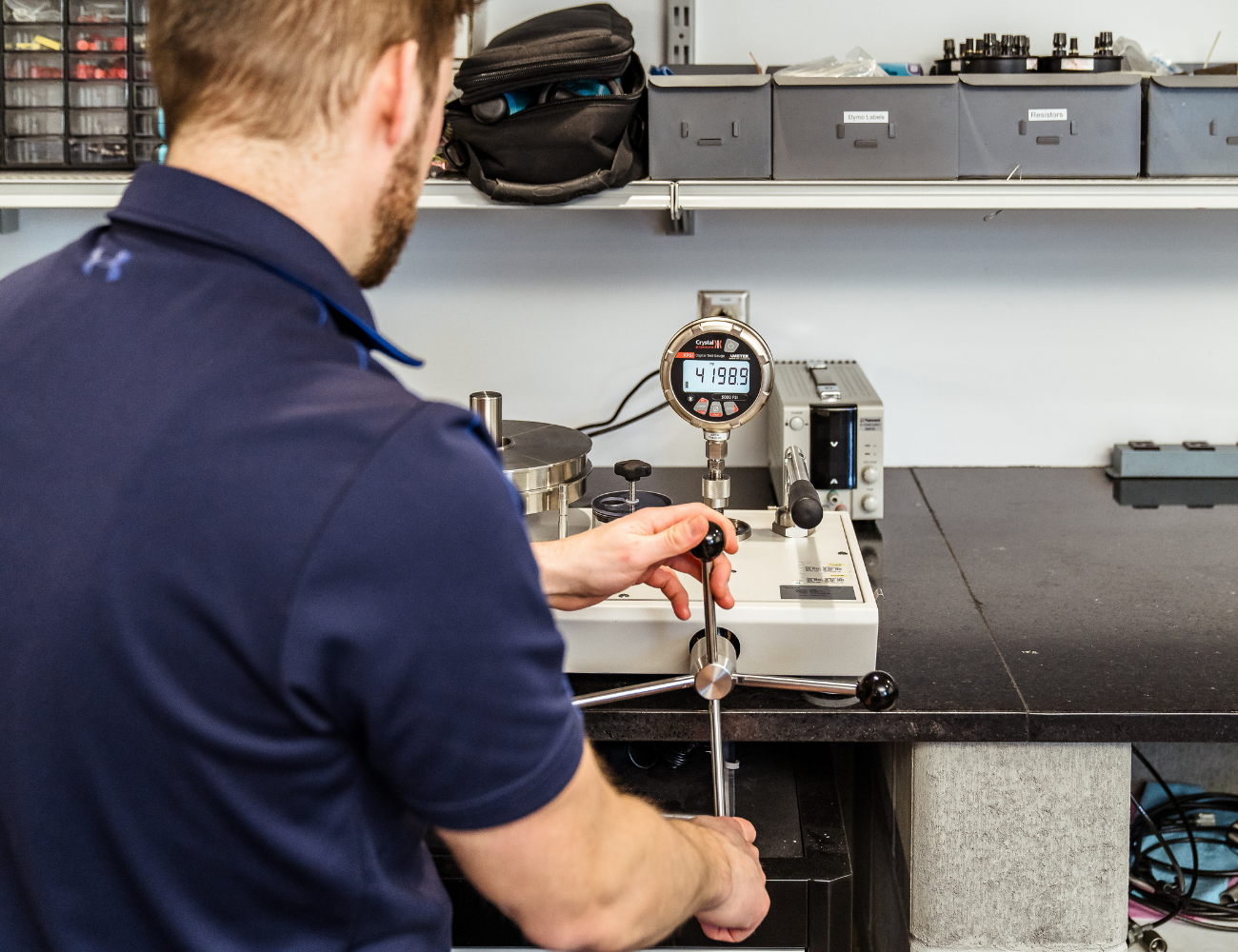
Whether you manufacture, calibrate, or use pressure instrumentation like pressure gauges, pressure sensors, pressure transmitters, or pressure transducers, ensuring their accuracy is extremely important for your application’s integrity. Without accurate pressure measurements, catastrophic machine failure could occur or even your batch processing could be compromised to the point where the product has to be recalled. Most pressure instrumentation comes with a certificate from the manufacturer that deems the instrument to be accurate for up to a year. After that point, readings could become less accurate. For those with sensitive processes like the pharmaceutical industry, inaccurate measurements could lead to large amounts of wasted product or even fines for not keeping your processes up to the governing body’s standards.
The good thing is that there are a lot of different pressure calibrators that can be used to make sure your pressure instruments are giving accurate measurements. In this post, we’ll dive into the benefits and drawbacks of pressure calibrators like deadweight testers, handheld calibrators, dedicated pressure calibrators, and even sending your pressure instruments to a calibration lab.
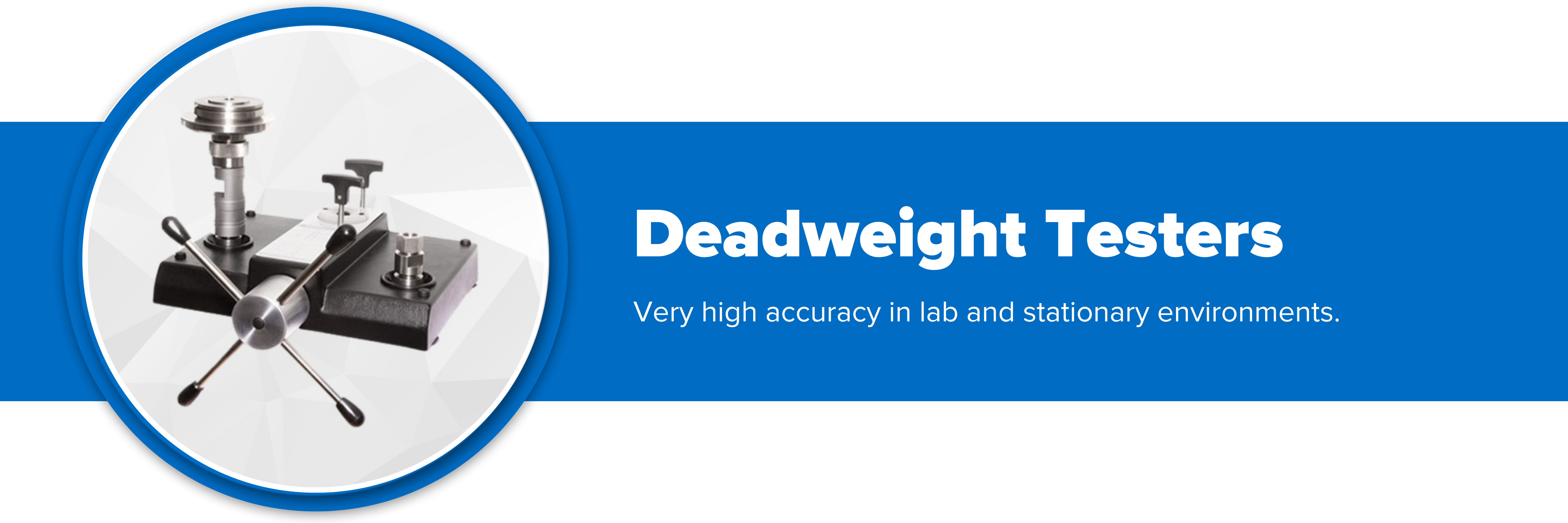
Deadweight Testers
What are Deadweight Testers?
Deadweight testers are pressure calibration devices that use known, traceable weights and precision machined piston and cylinder assembly to check the accuracy of pressure gauges, sensors, transmitters, and transducers. They rely on fundamental physics principles to determine pressure without the need for electrical signals. With unmatched accuracy, stability, and repeatability; deadweight testers are universally accepted as a primary standard for pressure calibration.
Most deadweight testers come as benchtop models and are used in lab environments where they can calibrate high-end pressure gauges, transmitters, transducers, and even other deadweight testers. This is because they require a stable environment in terms of temperature, barometric pressure, and humidity. There is software that takes these factors into consideration when carrying out pressure calibrations.
There are also deadweight testers that are more commonly seen in industrial applications where companies need to calibrate their own pressure gauges or transmitters in-house. There are some smaller benchtop models that can be used in the field, but portable models are often preferred. Portable deadweight testers come with handles and cases for the unit and the weights to be transported for in-the-field pressure calibrations.
Deadweight testers can be hydraulic or pneumatic. Hydraulic deadweight testers use liquids like oil or water, whereas pneumatic deadweight testers use gases like oxygen or nitrogen.
Benefits of Deadweight Testers
People turn to deadweight testers to calibrate their pressure gauges, sensors, transmitters, and transducers when the highest possible accuracy is needed. It’s the simplicity behind the technology that allows deadweight testers to have unmatched precision and repeatability without the need for re-calibration. With the weights and piston in the deadweight calibrator, pressure instruments are calibrated with the basic principles of pressure = force/area. You don’t have to worry about electronic interpretations and components within the calibrator that might lead your calculations astray over time.
Because of their simplicity and reliability, deadweight testers are used to calibrate pressure instruments in controlled environments, like in a lab. With this level of precision and control comes unparalleled pressure ranges and accuracy. For example, the WIKA DH-Budenberg CPB3800 Hydraulic Deadweight Tester has a range of up to 16,000 PSI and an accuracy down to 0.025% of a reading.
Drawbacks of Deadweight Testers
As with all precision pressure instruments, strengths in one area can lead to drawbacks in others. Deadweight pressure calibrators are typically bulky and heavy, and since they need consistent environmental factors like temperature or barometric pressure to keep their accuracy, using them in the field becomes very difficult or impossible.
Since deadweight testers utilize basic physics principles, some training is typically required to learn how to properly use them and handle conversions between pressure units. There is software that exists to help with these conversions. Lastly, deadweight testers aren’t really built to handle a large number of pressure gauges like handheld pressure calibrators are.
Who Uses Deadweight Testers?
If you can get proper training and can have a controlled environment for the deadweight tester to be used in, they are a great option and very worth the investment. For example, in the oil and gas industry, the pressure gauges being used have extremely high-pressure ranges - many up to 15,000 PSI. Even if having a pressure calibrator in the field is important, the high-pressure range takes precedence and makes the deadweight tester a clear choice.
Some applications require in-the-field pressure calibrations, like a petroleum company that needs to pressurize its system to test for structural integrity. Accuracy is still of utmost importance, so utilizing the measurement principles of a deadweight tester is often preferred. A portable deadweight tester like the DH-Budenberg Model 80 can be used for these types of scenarios.
There are also many calibration labs that can calibrate pressure gauges, pressure sensors, pressure transmitters, and much more. Since they have a controlled environment and rely on extremely precise measurements for a wide range of products, the accuracy and pressure range of deadweight testers make them a great fit. They even enable calibration labs to calibrate other pressure calibrators. In short, deadweight testers are the industry standard for when extremely precise calibrations are needed.
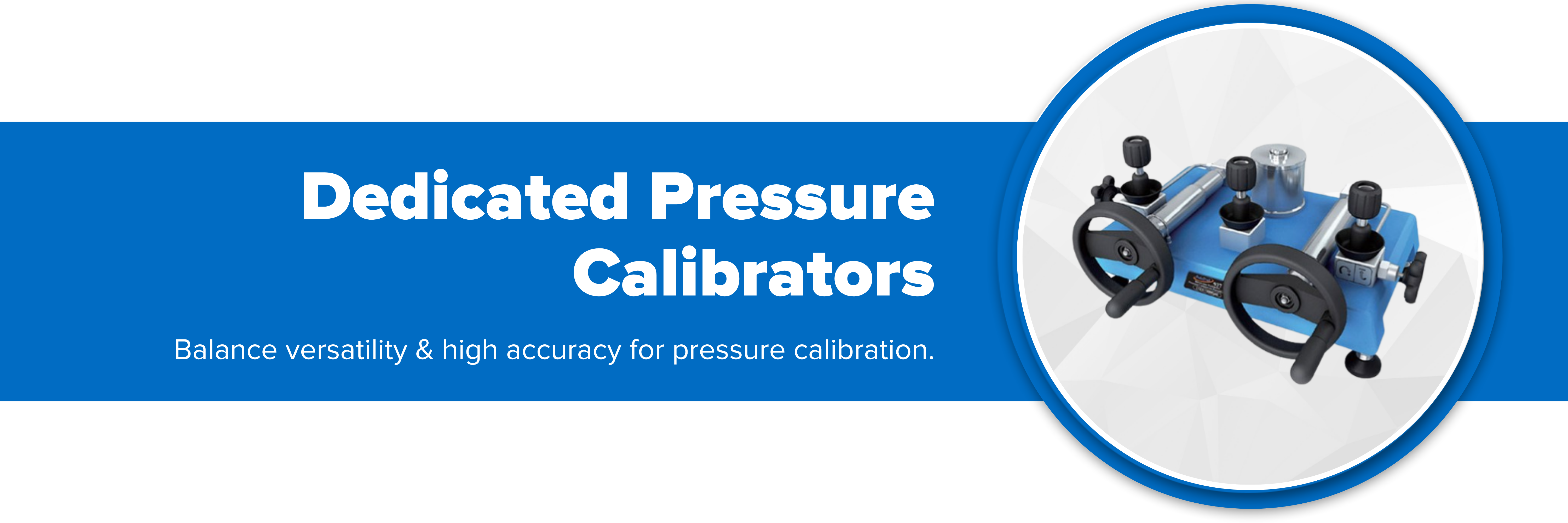
Dedicated Pressure Calibrators
What Are Dedicated Pressure Calibrators?
Dedicated pressure calibrators and pressure controllers are instruments that perform a wide range of pressure tests and calibrations on pressure gauges, pressure sensors, pressure transmitters, pressure transducers, and more. They can even perform automatic conversions rather than manually calculating them yourself. We use the term “dedicated” here to distinguish these types of pressure calibrators and pressure controllers from other types of multifunction calibrators that can also perform calibrations for temperature and electrical instrumentation.
Benefits of Dedicated Pressure Calibrators?
For those who need to perform a range of pressure tests, or calibrate a large number of pressure gauges, dedicated pressure calibrators are often sought out for their throughput and ease of use. Unlike the training required for deadweight testers, dedicated pressure calibrators and controllers are very easy to learn and operate with modern, intuitive designs and menus. No need for manual conversions either, since modern pressure calibrators can do that for you.
These pressure calibrators are able to perform sophisticated functions such as ramp-up pressure testing and burst testing for pressure gauges and more.
Drawbacks of Dedicated Pressure Calibrators?
Since dedicated pressure calibrators like the Druck PACE5000 Modular Pressure Controller are designed mostly for lab or benchtop use, they tend not to be portable for in-the-field use. If you also need to calibrate electrical or temperature instruments, these sorts of calibrators will not suffice without significant modifications. For compound ranges, a pressure source and vacuum pump will need to be plugged into the pressure calibrator in order to work properly.
Most dedicated pressure calibrators and pressure controllers have a range of up to 3,000 PSI, and while this range is quite feasible for most applications, it can exclude them from high-pressure applications that rely on a deadweight tester or more expensive multifunction calibrator.
While there are added conveniences that come from the electronic components and modern technology, most dedicated pressure calibrators are considered a secondary standard as opposed to a primary standard like deadweight testers, as was discussed earlier in the post.
Who Uses Dedicated Pressure Calibrators?
Dedicated pressure calibrators are often used by manufacturers as they build and/or calibrate the pressure instrumentation that they make. For example, we work with one manufacturer that relies on a benchtop pressure calibrator for the manufacturing and stress testing of their analog and digital pressure gauges, pressure switches, and more. Similar to deadweight testers, these sorts of pressure calibrators are also used in calibration labs for general testing and calibration of their customers’ pressure gauges, transmitters, and transducers.

Handheld Pressure Calibrators
What are Handheld Pressure Calibrators?
Handheld pressure calibrators are portable, battery-powered units that calibrate and configure pressure gauges, pressure transmitters, pressure sensors, and more. They enable quick calibration and configuration of a large number of pressure instruments with minimal setup time. Many models have multifunction capabilities so they can also calibrate and configure other electrical instrumentation. The multifunction capabilities of these kinds of pressure calibrators work especially well for pressure transmitters with a 4-20 mA output so the operators can be confident that the current output is in line with the reference pressure coming from the calibrator. Without this capability, a multimeter or some similar instrument would be required to power the transmitter to see if its current output is accurate.
Handheld pressure calibrators come with a range of advanced features and modular designs. For example, the Druck DPI 880 Multifunction Calibrator allows for a “plug-and-play” design with pressure modules ranging from 25 mbar up to 700 bar. It can read a range of electrical inputs and even has the capability for simultaneous dual reading. And, as with many handheld calibrators, it has easy-to-use menus and buttons with convenient one-hand operation.
These advanced features often come with a larger price tag, which makes some operators prefer something simpler like a hand pump pressure calibrator. This type of handheld pressure calibrator utilizes hydraulic or pneumatic sources to calibrate a reference pressure gauge that is then used to calibrate other gauges. This works quite well for more basic pressure gauges where advanced features aren’t important. In fact, these hand pumps don’t even need an electrical source. Hydraulic hand pumps are normally used for pressure ranges above 1,000 PSI, whereas pneumatic hand pumps are normally used for lower pressures or when the operator doesn’t want hydraulic fluid contaminating their pneumatic pressure gauge.
Benefits of Handheld Pressure Calibrators
The most obvious benefit of handheld pressure calibrators is their portability. Technicians who need to be able to perform calibrations and configure their pressure gauges or sensors in the field rely on their portability and battery-powered capabilities. Because of their more modern technology, many handheld calibrators utilize communication protocols like HART or Fieldbus for seamless integration with your current system. Modern technology also allows for more simple operation and programmability. Many handheld pressure calibrators are multifunction, which means they can calibrate pressure instruments, electrical instruments, and temperature instruments all without you needing to purchase a different calibrator. This additional capability allows for easy calibration of transmitters where the 4-20mA output needs to be compared right in the field for easier adjustments. Some calibrators can even handle those field adjustments right from the device.
Drawbacks of Handheld Pressure Calibrators
While handheld pressure calibrators are convenient and often packed with features, they tend not to be quite as accurate as lab standard deadweight testers or benchtop pressure calibrators and are also considered secondary standards. Additionally, for high-pressure processes like in the oil and gas industry, the pressure ranges typical of handheld calibrators are quite limited compared to something like a deadweight tester.
Who Uses Handheld Pressure Calibrators?
Technicians whose applications use pressure instrumentation most commonly choose handheld pressure calibrators because of their versatility. Here are some specific ways we see them used.
Some applications like natural gas distribution require numerous measurements during the process, both from pressure sensors and temperature sensors. Each sensor transmits an electrical signal that needs to be properly calibrated as well. Multifunction calibrators like the Druck DPI 620 Genii are able to handle temperature and electrical calibration, and with an external pressure module and integrated pump, can also handle pressure calibrations.
In manufacturing, handheld pressure calibrators are often used to spot-check equipment. They might have critical pressure gauges on their machinery and the operators will want to check on a regular basis to make sure those gauges are accurate.
In the pharmaceutical industry, technicians are constantly checking their pressure and temperature accuracies for important machinery. If a reading becomes inaccurate, critical processes can become skewed since they rely on consistent readings. A multifunction calibrator is often used as a reference for both temperature and pressure readings.
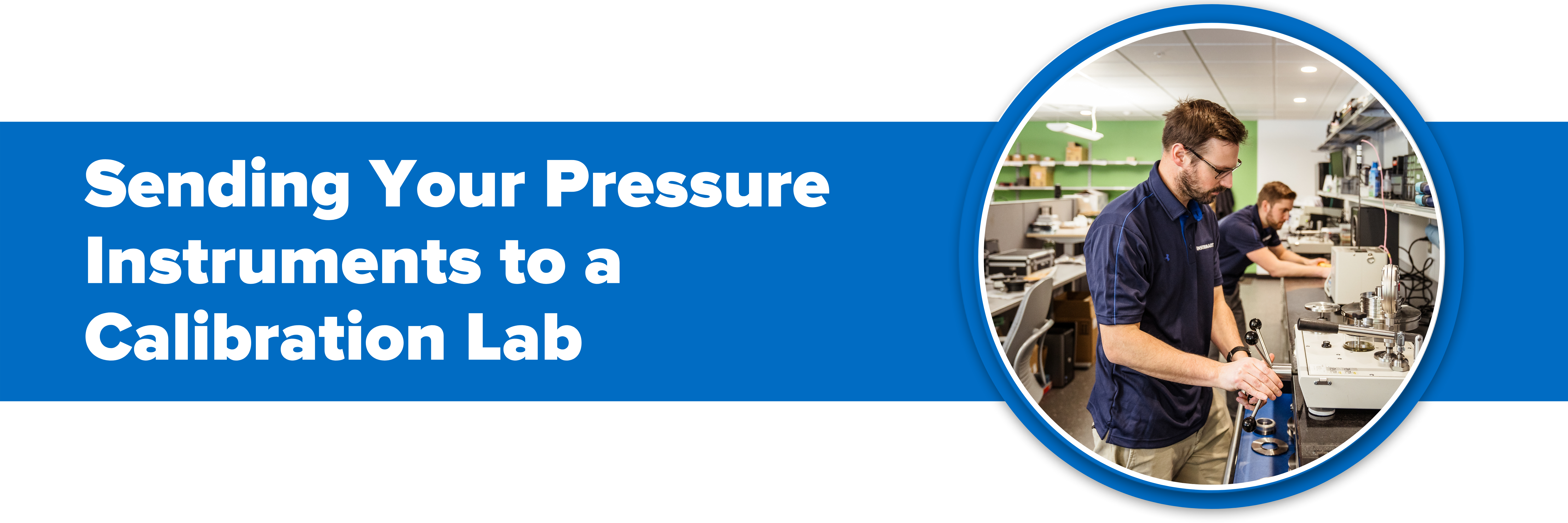
Sending Your Pressure Instruments to a Calibration Lab
What Are Calibration Labs?
When companies need or prefer to send their instruments somewhere to be calibrated, they will find a calibration lab. The calibration lab receives instruments and uses best-in-class calibration equipment and knowledgeable technicians that can use specialized software to make sure the products will take their measurements properly. The calibrations performed are traceable so the company can rest assured that their instruments will be accurate. Some calibration labs are smaller and specialize in certain products, while others are very large and act as a one-stop shop.
Regardless of size, calibration labs are limited by the accuracy of the standards of their calibrators. Calibration labs can also work to get additional certifications such as ISO that some companies look for when choosing a lab.
Benefits of Using a Calibration Lab?
Most standards require a yearly calibration for the instrument to stay up to industry standards or manufacturer specifications. Some companies are focused on their process, making it difficult to find the time or resources to calibrate their pressure gauges or other industrial instrumentation. They might prefer the convenience of sending their pressure gauges into a calibration lab instead. This is exactly why Instrumart has its own Calibration Lab. Our engineers help find the right industrial instrumentation for complex applications, and we pride ourselves on providing lifetime technical support for every product we sell. But what if someone just needs a yearly calibration for their pressure gauge? We wanted to help our customers in that way as well. And because we fall into more of the “specialized” lab category, we are able to calibrate and repair instruments in an average of five business days or less.
Some applications necessitate a level of precision that can only be met by calibrating the pressure gauges with a complex calibrator like a deadweight tester. Rather than making the large capital investment or time spent training to incorporate complex pressure calibrators into their process, many companies prefer the annual expense of sending their pressure gauges to be calibrated in a lab.
Some calibration labs even offer on-site calibration services, which benefits companies that cannot afford the downtime normally required to send their instruments to a lab. Being based in Vermont, our calibration lab works in the field for a local meat products company that needs to calibrate their temperature probes or another local company that needs their Fuji controllers calibrated on a regular basis.
Lastly, most calibration labs will be able to provide traceable calibrations so that you can certify that your pressure gauge will be accurate. For example, Instrumart’s calibration lab uses NIST-traceable standards for calibrations. Many companies consider this a must-have when they need their industrial instrumentation calibrated.
Drawbacks of Using a Calibration Lab?
Some critical or complex processes may prohibit companies from sending their pressure gauges and other instrumentation into a calibration lab. The sheer volume of the instruments needing calibration may make it cost-prohibitive, making it a better choice to invest in a calibrator of their own. Or, as a company grows and time becomes a greater priority for their process, the financial and time cost of annual calibrations might not be the best option because of the required downtime in their process.
In short, if time or the recurring expense of sending your instruments into a calibration lab is a major concern, it may be time to invest in a pressure calibrator that best suits your needs.
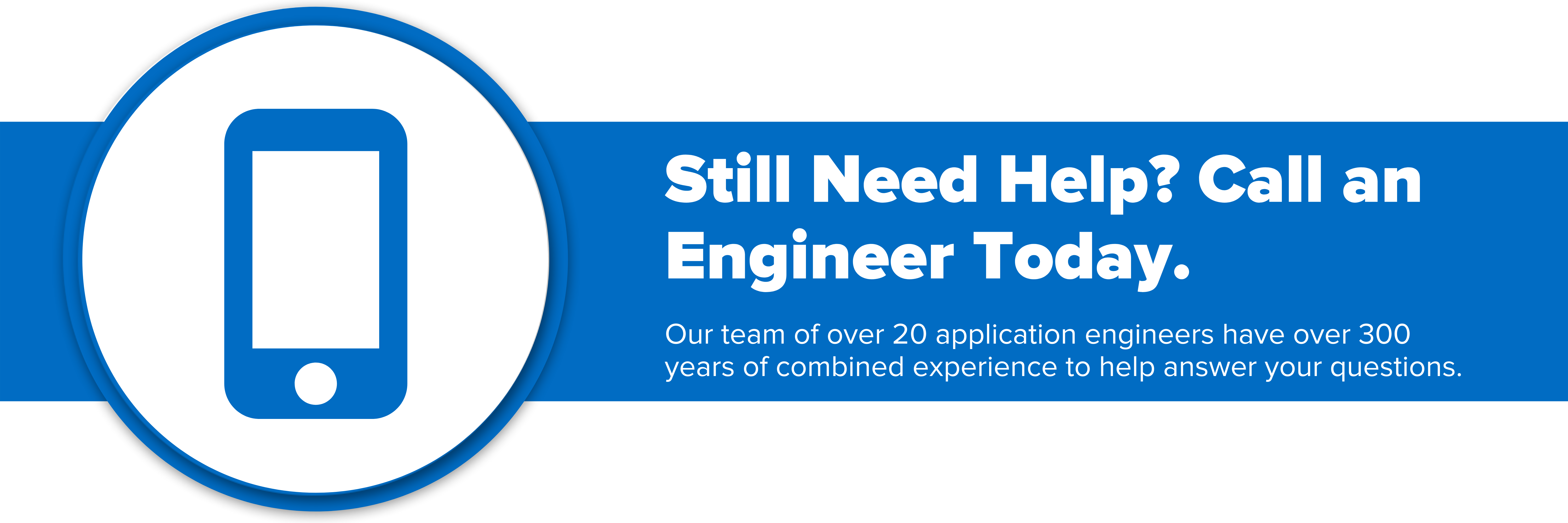
Still Need Help? Call an Engineer Today.
If this guide still leaves you wondering what type of industrial instrumentation would work best for your application, our engineers would be happy to help you. Give them a call at 1-800-884-4967. Or, you can shop for a wide range of flow industrial instrumentation from top brands and even configure your product online. We offer free lifetime tech support with every product sold.









